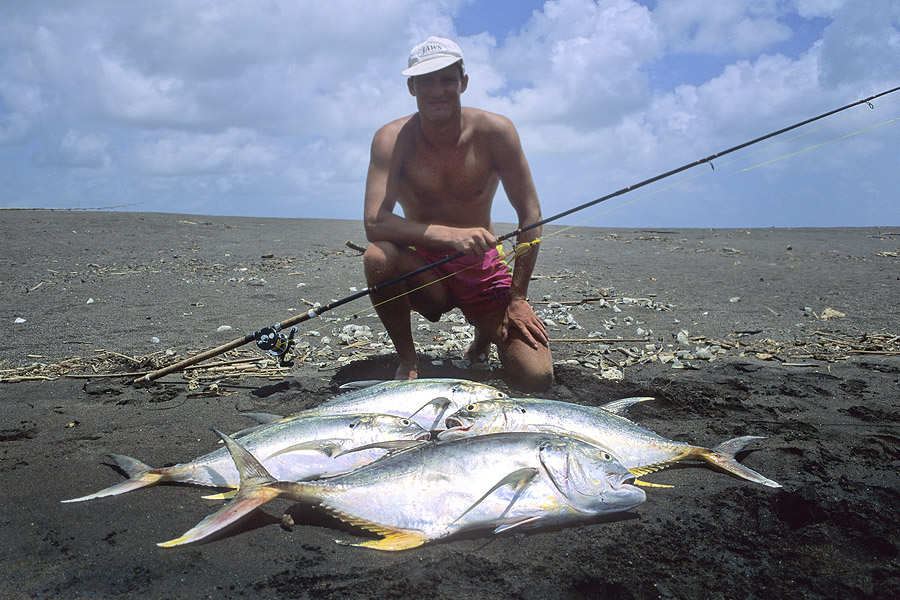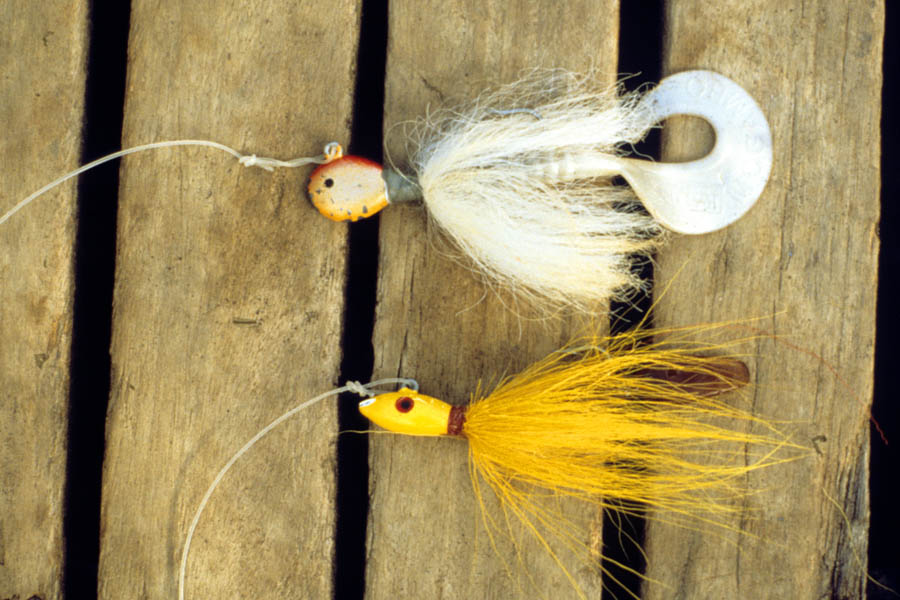 (1993) The reasons for fishing are many. Mostly, for the love of the fishes, life and nature. But when the fish you want clear your reels of line, chew your baits to pulp, break your lines and shatter your rods, isn’t it then a matter of war?
(1993) The reasons for fishing are many. Mostly, for the love of the fishes, life and nature. But when the fish you want clear your reels of line, chew your baits to pulp, break your lines and shatter your rods, isn’t it then a matter of war?
The vast and intense green foliage of the Costa Rican rainforest is virtually impenetrable, which is why my friend Claus and I hired a local to take us fishing in his canoe. There, we primarily searched for the small and beautifully coloured mojarra and guapote cichlids, which live in between roots and under overhanging vegetation at the jungle-banks.
These fish, which grow to about 3 lbs, fight very hard on light tackle. In fact they taste delicious aswell, but eating them, I am sure, would make any aquarium fanatic start crying, as the fishes of that size are worth a small fortune here in Europe.
All around us the animals, birds, turtles and alligators live their fairly quiet life, the calm atmosphere only broken by occasional explosive splashes from tarpon chasing prey. The tarpon in the jungle-channels were extremely hard to catch at the time we were there, and we didn’t hook any either, but as a relatively good compensation we caught several machacas (tetra) and topsail catfish on light tackle. The machacas grow to only about 7 lbs, but they fight as wildly as tarpon, look like ide and have teeth like a piranha. We actually caught what is considered a serious specimen of 6 lbs.
After this, our goal was the tarpon at Rio Colorado, where it flows into the Caribbean Sea. The river delta here is according to many the best place in the world for big tarpon, and that’s what the Americans have found anyway, building several huge lodges for this sole purpose.
The first to discover this was an American, Archie Fields, who promptly built his world-famous Rio Colorado Lodge in Barra del Colorado, only a few hundred metres from the river mouth. Now big numbers of money-strong American anglers treasure the lodge’s pampering facilities and excellent fishing.
We didn’t intend to throw thousands of dollars into this business, though, but contacted the locals, who were more than willing to accommodate us with both fishing and a place to hang our hammocks for next to nothing. The real secret to this was the fact that our ability to speak Spanish broke the barriers between us and the locals, and thereby distancing us from the ignorant "gringos". The local shark- and langoust-fisherman, Miguel, treated us to some mind-blowing fishing in his 21 ft dinghy. He had to go to the ocean to clear his hooks and nets anyway.
 Our first day on the ocean left us utterly "bitten by the bug" after losing a tarpon each, but three more days went by before we got another chance at these magnificent silver kings. Departure at 05:30. Directly to sea through the wild and furious river mouth, where a couple of dolphins accompanied us for a few minutes.
Our first day on the ocean left us utterly "bitten by the bug" after losing a tarpon each, but three more days went by before we got another chance at these magnificent silver kings. Departure at 05:30. Directly to sea through the wild and furious river mouth, where a couple of dolphins accompanied us for a few minutes.
It didn’t take long for Ronald, Miguel's talented son, to spot a school of silvery backs in the choppy water, and after another five minutes even our Danish nearsighted eyes could see them aswell. We followed them at safe distance and placed us up-current, letting the boat drift toward them without the motor running. The water was splashing all over the place, hundreds and hundreds of tarpon chasing prey. Frantically we cast out our big hairy jigs, and they hardly hit the water before fish struck them.
Both of us had tarpon on. Guano screamed „Hit it, Hit it“, and we did our best to try and sink the hooks into the tarpons hard, bony mouths. Suddenly Ronald hooked a tarpon on his thick hand-line, and everything went into a crazy inferno of jumping silvery fish around the boat. Claus lost his fish after a few minutes, but another hit the jig right next to the boat. Again, Guano screamed out his only English „Hit it, Hit it“. With crossing lines, madly fighting silver giants and crazy anglers shouting at each other, we must have been quite a sight.
Eventually I lost my fish in a jump, then Claus’ broke his line, and finally Ronald lost the last one. Four big tarpon hooked, none landed and the big shoal had completely vanished in the meantime. We were like thunderstruck after this adventure, but had to realise the truth of veteran tarpon-anglers saying, that there’s only a 20% chance of landing even a well-hooked tarpon.
A few days later Don Miguel himself was at the helm. Again we didn’t stand a chance of spotting the tarpon before the local’s trained eyes had them sought out. We quickly got our lures in the water and began jigging them the best we could. Claus got the first take, and everybody yelled „Hit it, Hit it“. But it didn’t take long to realise that what was on the hook wasn’t a tarpon. It went deep and hammered 200 meters of line off Claus’ multiplier, before he had a chance to adjust to this new type of fight; and it took another 20 minutes before a 14 lbs Jack hit the surface.
 Claus was completely agape. He simply couldn’t comprehend that such a comparatively small fish had him fighting his butt off for so long. We landed some more of these Formula1-fish, that are possibly the strongest fish in the world, when bodyweight is compared. A Jack weighing about 30 lbs even broke my much-tested mahseer-rod, which had landed 90 lbs mahseer and 50 lbs king salmon. Unfortunately, the rest of that day went by without further contact from tarpon or jacks.
Claus was completely agape. He simply couldn’t comprehend that such a comparatively small fish had him fighting his butt off for so long. We landed some more of these Formula1-fish, that are possibly the strongest fish in the world, when bodyweight is compared. A Jack weighing about 30 lbs even broke my much-tested mahseer-rod, which had landed 90 lbs mahseer and 50 lbs king salmon. Unfortunately, the rest of that day went by without further contact from tarpon or jacks.
We fished for two more days with similar experiences, and both days the tarpon gave us a taste of their stunning fighting capabilities, leaving Claus and I with an everlasting image on our retinas of exploding silver over Costa Rica's blue-water. And one thing is for sure: we will be back...
It is quite easy and inexpensive to fly to Costa Rica. When in Costa Rica’s capital San José the possibilities are many, but the easiest way is to fly directly to Barra del Colorado.
The best seasons for tarpon are March to May and September to December. The fishing requires a boat, whether you do it the local way or the lodge way. Both spinning and fly-fishing in either the rivers or the sea makes for excellent sport.
The average weight of the tarpon lies around 70 lbs, but many 100 pounders were landed, while we were there. The local tarpon record is 185 lbs. Snook, are caught to 52 lbs, which is actually the all-tackle world-record. And besides that, there are masses of shark, rays, sawfish, all kinds of biggame fishes, trout in the mountains and of course a variety of exotic aquarium fishes in the rainforest.